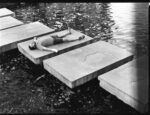Processes, not products
Financial support programmes in the field of performing arts should cover both the pre-performance stage of exploration and experimentation, as well as the production work itself. The city can help artists through scholarships and residencies and by facilitating access to other resources, such as rehearsal spaces and workshop studios. This holistic approach aims to bridge the gap between city institutions and scholarship holders.
The perspective of female creators
It is crucial that female and male performers develop their artistic practice as part of a process that will not be focused on predetermined outcomes. Therefore, fellowship and residency programmes should take into account the need to work outside the project system as well as traditional modes of production. This approach allows art and creativity to flourish and is particularly important at the beginning of an artistic journey.
Adopting a process-oriented mindset over an effect-oriented one provides comfort for artistic work and is extremely important for understanding how the arts are funded. Katarzyna Sztarbała, a choreographer and scholarship holder of the City of Warsaw shared her experiences of confronting institutional expectations. “In the choreographic arts, the reorientation of attention towards artistic research, practice and process has been endorsed and practised for years. However, the confrontation with theatres or venues producing exhibitions is always painful for choreographers because the specificity of their work means that they may not know what the final work will look like for a long time. What we need is for institutions to understand our work’s specificity and trust the artists”, Sztarbała said.
“It is very important to distinguish between an artistic production and an artistic process; both should be supported. We need time to discover, try, and test ‘bad’ practices to find out which are good ones. This space of exploration needs to be funded separately”, stressed Romuald Krężel, an artist working in the field of performing arts.
The institution's perspective
The less regulation and bureaucracy, the more opportunities for the development of art. Artur Jóźwik, Director of the Culture Bureau of the City of Warsaw, noted that residency programmes offer greater flexibility. In the case of scholarship agreements, there are more expectations of specific outcomes, as art scholarships are limited by legal regulations under the law. On the other hand, residency programmes operate under contracts between institutions and artists, allowing for a less formalised approach and a greater focus on the artistic process, rather than predetermined outcomes.
For the first time in its recent history, Komuna Warszawa is running residencies without the pressure of delivering a specific end product. “Perhaps their results will one day develop into something that can be incorporated into the programme, but that is not their objective. At the same time, however, we are testing this mode of operation with great caution. It is important to remember that confronting the audience is why we do art in the first place”, explained Grzegorz Laszuk the co-founder of Komuna Warszawa.
The long-standing residency programme at the Ujazdowski Castle Centre for Contemporary Art (CCA) has shown that it can serve as a valuable curatorial tool, but it should be embedded in the institution’s long-term collaboration with artists. Ika Sienkiewicz-Nowacka, the curator of the CCA’s residency department, pointed out that the absence of a product does not mean that the residency has no impact. “They can be highly diverse. Residencies can be conducive to a book, a walk, or a workshop, but also simply a meeting of a group of people. We do not expect specific results from the artists; we give them resources and means. I am an advocate of taking care of both relationships and oneself, especially as a process subordinated to a production outcome can be very exhausting. It is not necessarily necessary to rush, what matters more is to build trust and the fruits of labour will come. The exhibitions Gotong Royong, Dust or Everyday Forms of Resistance are evidence of this”, Sienkiewicz-Nowacka said.
How does it work in other countries?
In Germany, a distinction is made between grants and production grants. Self-employed artists apply for funding allowing them to collaborate with institutions that do not have their budgets and act as co-production houses. In this system, grants take on another function – if production is based on a grant system, support can be given in the form of a stipend for development and research. One example of this is the Tanzpraxis programme initiated by the Berlin Senate Department for Culture and Europe. This 18-month scholarship, modelled on the Norwegian system, empowers recipients without the pressure of delivering a finished project. “The money can be used for the work that goes on in the shadows, so to speak, such as training, development and the continuation of one’s explorations, which are key to the subsequent production of a performance or a good show”, said Mateusz Szymanówka, a dance curator from Berlin’s Sophiensaele.
Drawing on his artistic education and work experience in the Netherlands, dramaturge, and director Szymon Adamczak stressed the importance of regulating the status of the artist. In the Netherlands, artists operate as sole proprietors and are required, like all citizens, to pay health insurance contributions. Such regulations facilitated the smooth distribution of state-funded aid during the COVID-19 pandemic. As is the case in Germany, in the Netherlands, scholarships also fill institutional gaps. A good example of this approach is the 3Package Deal awarded by the city of Amsterdam, which is a comprehensive support programme offering housing, workspace, a stipend for personal development, and support from Amsterdam’s art and design institutions. “This is an example of operating within a cluster system, where several institutions join forces to support a given project, due to which what we get are many extended artistic ventures. It is essential to network and think beyond competitiveness,” stressed Szymon Adamczak.
Realities and expectations
“I am an artist, a producer, a coordinator, a curator, a masseuse, I do community projects, and it is very difficult to fit everything in one basket”, said Katarzyna Sztarbała, illustrating the challenges faced by underfunded artists who juggle multiple roles. The struggle to balance various jobs inevitably takes a toll on the quality of their artistic pursuits, despite receiving scholarships. Beyond financial aid, artists yearn for additional resources that the city can offer without necessarily increasing scholarship budgets. Top on the list are rehearsal spaces and networking opportunities, connecting them with art institutions and NGOs.
Initiatives to support independent performing arts are still few and far between, and demand is very high. “There is very little state support in this area. In Poland, artists have few opportunities to benefit from residencies”, said Ika Sienkiewicz-Nowacka.
Grzegorz Laszuk spoke about the idea of creating a Warsaw Residence Centre. “For this, however, we need not as much of an economic but more so a political decision on the part of the city. The school building currently occupied by Komuna Warszawa, which used to house the Hoffmanowa High School, could serve as a base not only for performative activities but also a means to endorse a city-forming mindset about space and its accessibility.”
Supporting the self-organisation of artists and providing them with resources is a tool for establishing urban culture. Szymon Adamczak said that we need to think broadly about the ecosystem of support for the performing arts: “Warsaw has become a multinational city, its wealth in the field of dance and theatre is great. There are people living here who have returned from studying abroad — they have amazing experiences but few opportunities to enter the world of arts production and distribution. So what we need now is to build bridges between the fellows and the institutions,” Adamczak concludes.





